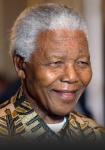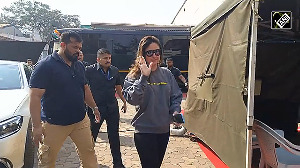Once again, religious sentiments have been hurt -- this time in Kerala. And the culprit is a small portion of a lesson from the social science textbook for class VII. It has been alleged by groups claiming to represent Muslims and Christians that this particular lesson preaches atheism. It sticks because the government publishing the textbooks is led by the Marxists and there is a perception that the Marxists have a pathological hatred for religion. But first let us try to look at the facts.
The text under attack is part of the second chapter of the textbook titled 'The Land of Humanness'. The chapter seeks to introduce the issues of caste and religion in the classroom. Doing away with the traditional method employed by most textbooks, here the child is exposed to some news clippings and stories related to cases of caste discrimination The students are asked to examine a table from an admission register of the year 1924 of a Kerala school. It wants the child to look at the column of caste and understand a social context in which children from a particular caste form a majority in the school. With the help of the teacher, the children are expected to analyse the table and find out if there are students who do not study because of caste discrimination.
The chapter also talks about various reform movements undertaken by Hindus, Muslims and Christians to fight caste discrimination. After this discussion, the chapter moves on to an imaginary situation of a child Jeevan coming to a school with his parents seeking admission. The headmaster starts filling the admission form and finds out that the father of the child is Anwar Rashid, a Muslim and the mother Lakshmi Devi, a Hindu. The headmaster has to fill the column of religion of the child and the parents tell him in simple words, "need not record anything, write no religion." They also want him to leave the column of caste empty. The headmaster asks what if he wishes to have a religion when he grows up. The parents tell him, "In that case let him choose the religion of his choice."
This imaginary dialogue between a couple and a headmaster has set Kerala on fire. We can see that the text does not advocate atheism in any form. It seems that the protesters have not moved a line beyond the heading given to the section 'No religion for Jeevan', which is quite misleading. They have not cared to read the closing sentence of the dialogue 'Let him choose the religion of his choice'. Horrified with the heading, they ignore the fact what follows this dialogue is an opportunity for the child to discuss the teachings of different religions like Hinduism, Islam, Christianity and Sikhism. Leading the child to read extracts from the holy books of these religions, the texts asks, 'What are the instructions of religions which aim at mutual love regarding human behaviour?' they are asked to collect newspaper reports, notes, notices which demonstrate that 'All religions aim at the virtue of man. Teach to live in toleration. We can experience many occasions in which people belonging to different religions work together.'
Finally the child is told that: 'All religions aim at the glory of the mankind. Exhort to mutual love and respect.' The chapter closes with an interesting and challenging exercise for the child. S/he is asked to imagine a situation in which a child from a different religion fleeing a communal riot takes shelter with him/her and after living together s/he finds that their religious practices and faith are entirely different. The child is asked to think about his/her response to this situation.
After reading the textbook and the controversial chapter we are left wondering as to what could have led the opponents of the book to conclude that the chapter promotes atheism. One would have appreciated their objection to the heading which does not fit with the content of the text. You could also criticise the particular chapter and the whole book on other grounds. For example, it can be said that the construction of the book is flawed, the chapters lack interconnection.
It does not show sensitivity to the issue of gender in particular. There are jumps and jerks and the book is episodic in nature. There are grammatical errors and the language employed is quite indifferent and colourless. Little attention has been paid to the matters of style. It has been too densely packed with issues and is very ambitious and demanding on the teacher and the student. It does not have any introductory chapter which could have spelt out different strategies to be used in different classroom situations by the teachers. Bad quality of the paper and printing could form another ground of criticism.
The critics demanding withdrawal of the book are not bothered about these issues. And that leads us to a very disturbing and depressing conclusion about the nature of the discourse on education obtaining in our society. It seldom goes beyond the content of the textbook. While it is important to ask which personality has been included or excluded, what is the incident which has been mentioned or omitted, they are hardly the real issues we should be discussing when examining a textbook. The fundamental question to be asked is: What is the educational or pedagogical principle on which the textbook has been designed.
Does it create opportunities for a child to examine the content of the textbook and form his/her opinion or does it simply expect them to accept the truth of the text, memorise it and reproduce it in the examination hall? Does the textbook act as an authorised mouthpiece of the ruling ideological dispensation or does it open up windows for the child which could lead him/her to different worlds of interpretations and decide which one is the best? Is s/he allowed to change his/her opinion at any stage which would help him/her understand that ideas get birth amidst contestations and there is always a beyond to what we know as final.
We have never tried to know as parents or guardians how a textbook differs from any other book. Is it only the politics or ideology that matters? Is a textbook to be written with a capital T or is it only one of the many tools which teachers and students proceed to organise their educational experiences at different levels? Is the textbook an academic exercise when been written and used or it is merely a set of state approved facts and ideas which are permissible in schools because schools are part of the state apparatus and a means to fashion out 'good' citizens.
The critics of the Kerala textbook need to take a pause and ponder over the question raised here. We know, unfortunately that they would not do so. The reasons could be many. Not to lose an opportunity to embarrass the party in power could be one reason. But it would not be quite out of place to ask our Leftist historians and ideologues as to what was there in the curriculum and textbooks evolved by the NCERT in 2005 and the following years under the guidance of Professor Yashpal and co-ordination of Professor Krishna Kumar that provoked them to unleash a vicious ideological campaign against the textbooks and the educational philosophy which constituted them? Did they not on the platform of SAHMAT launch an assault on the whole exercise which is now well documented in a volume of the journal Social Scientist?
They ridiculed and lambasted the constructivist educational philosophy and lamented that it would undermine the sanctity of the disciplines and would promote, in the name of giving value to the local culture, superstition and backward principles. They questioned the principle of the child being allowed to form his/her opinion. Does s/he have the capacity, they asked. They also opposed teachers being given the freedom to use more than one prescribed book in the classroom and use other teaching material. Can the teacher be trusted? They resented and opposed the decision of the NCERT to replace the history textbooks written by Ram Sharan Sharma, Bipan Chandra, Satish Chandra and Romila Thapar which were in use for more than three decades with a new set of books prepared by younger history practitioners using different kind of pedagogy.
It is very interesting and in a way ironical to see a Left government initiating a process of curriculum development and textbook writing following the educational philosophy and principles of constructivism and it being defended on the platform of SAHMAT which had not too long back trashed the same philosophy in the name of defending secularism. What it demonstrates is that our political and academic circles care very little about matters of pedagogy. They also lack a capacity to deal with issues of school education. They are not ready to accept that it is not at all necessary that a great historian possesses the ability to write a good class VII history textbook as it requires a very different kind of training.
It is the insecurity the religious and ideological groups suffer from when faced with the real demands of a liberal, democratic polity which asks them to treat each human being as a unique personality who can decide for him/herself leads them to raise controversies like the one poor class VII textbook is facing now. In the name of cultural and religious identity, national pride, secularism and nation our classrooms are prevented from asking uncomfortable questions. The learner and the teacher are not trusted, we do not treat them as intelligent beings. Outside school spaces, people are treated in the same fashion by these groups. The attack on a Ramanujam text, an Ashis Nandy article, a Husain painting, a James Laine book, burning of an R S Sharma book, the campaign against the new textbooks prepared by the NCERT has something in common with the Gujarat genocide and the Nandigram operation. It is for us to realise this.
It is for the larger academic community, in and outside Kerala and people in general to ask if they are going to remain prisoners of their self-styled guardians or assert and secure for themselves the rights secured by them and enshrined in the Constitution, to think for themselves, decide for themselves. The Kerala textbook controversy is yet another occasion for all of us to discuss these issues and take a step forward in the direction of setting our classrooms, teachers and children free.






 © 2025
© 2025